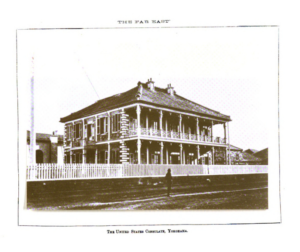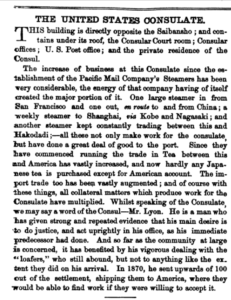Foreigners in Treaty-Port Japan (1859 – 1872)
In 1854, with the Treaty of Kanagawa, Japan’s ‘closed country’ sakoku policy was replaced with an ‘open country’ kaikoku policy.1 This open era created new markets, new distribution routes and critically opened new Treaty Port towns. The most significant of these was the Treaty Port of Yokohama. Yokohama’s success and use as trading hub was so significant that it led it to the town being known to be ‘synonymous with the West’.2 John Dower explores how the local Japanese viewed this new commercial hub and their new foreign counterparts through analysing Yokohama prints, Yokohama-e. Yokohama prints were woodblock prints that, during the 19th century, became an extremely popular way to depict Treaty Port towns and depict the actions of the new foreign merchants and traders. This blog entry will explore how the Yokohama prints illustrated; first, the different uses of the new Treaty Port towns, second the lack of knowledge or information the locals had about these new foreigners and, third the suspicion the locals attributed to the foreigners.
One primary source, Utagawa Sadahide’s ‘Pictures of Western Traders at Yokohama Transporting Merchandise’, 1861, will be the principal source for this blog entry; Dower uses it to gain an insight into the different activities within the thriving treaty port harbour in Yokohama. The woodblock depicts five vessels within the bustling Yokohama port and the various tasks that are occurring on them when they are coming into the harbour. The five vessels represent the five nations with bilateral treaties allowing them to use the harbour. Many different activities are occurring within the print, from clerks making notes to crewmen climbing the riggings. These various activities illustrating what Dower calls ‘the unprecedented bustle’3 in the Yokohama harbour and reinforces how Treaty Ports were a hub of trading, business and all the other activities that facilitated Japan’s new international markets. The American ship, denoted by an American flag, includes a long row of small cannons running along the length of their ship.2 The presence of these cannons, Dower views as a ‘subtle touch of the ominous’4, signalling the Japanese’s uncertainty and discomfort with their new open era; they now looked out ‘upon the unknown world of foreign nations’.((Ibid.))Second, most critically, it displays the suspicion attached to foreigners in Yokohama. Locals still were sceptical of the Americans after their aggressive ‘gun-boat diplomacy’ which triggered the kaikou policy. It further illustrates how alongside treaty port towns being a hub of commerce, they were also a place where foreigners could display their naval strength. As Jeremy Taylor explores, the harbour in Yokohama was ‘on occasions lined with foreign troops of all kinds to intimidate Japanese government officials into further concessions’.5
It should be noted that, as Dower argues, it is unlikely that Sadahide was creating this print based on his first-hand view of the harbour. Dower explores how a similar European port scene appeared in the Illustrated London News before the publishing of Sadahide’s print, and this had potentially been the inspiration behind Sadahide’s work. This use of a European source to depict Yokohama’s harbour exposes again the lack of understanding and great uncertainty that Japanese locals and artists had towards these foreign nations and this new influx of trade and chaos. Dower emphasises how often different features of the woodblock prints were a ‘departure from strict reality’.6
Overall, Sadahide’s woodblock print is used by Dower to draw conclusions about the Yokohama local’s impression and interactions with their new foreign counterparts and their attitude towards the new use of their previously quiet village. It is clear the locals viewed their foreign counterparts with caution and uncertainty, often relying on European sources or images to fill their lack of knowledge of the new concepts and people that now surrounded them.
- John W Dower, “Yokohama Boomtown, Foreign Community in Treaty Port Japan 1859-1872,’” MIT Visualising Cultures, 2008, https://visualizingcultures.mit.edu/yokohama/yb_essay01.html, 1. [↩]
- Ibid., 27. [↩] [↩]
- Ibid., 25. [↩]
- Ibid. [↩]
- Jeremy E. Taylor, “The Bund: Littoral Space of Empire in the Treaty Ports of East Asia,” Social History 27, no. 2 (2002): pp. 125-142, https://doi.org/10.1080/03071020210128364, 137. [↩]
- Dower, Yokohama Boomtown, 27. [↩]

